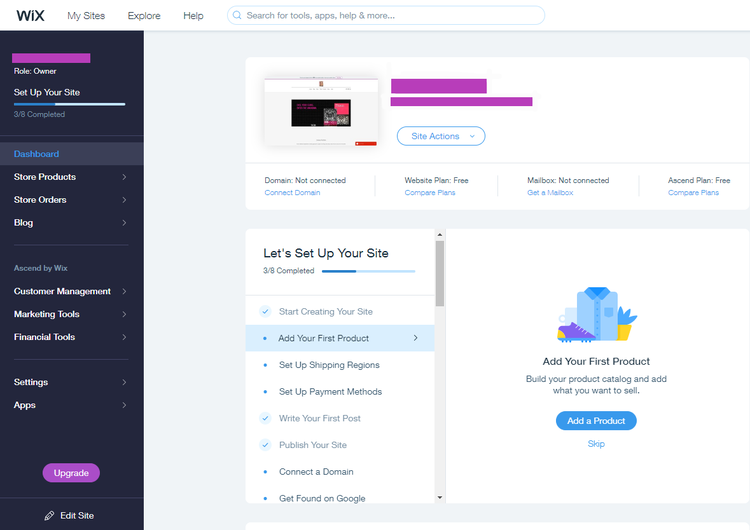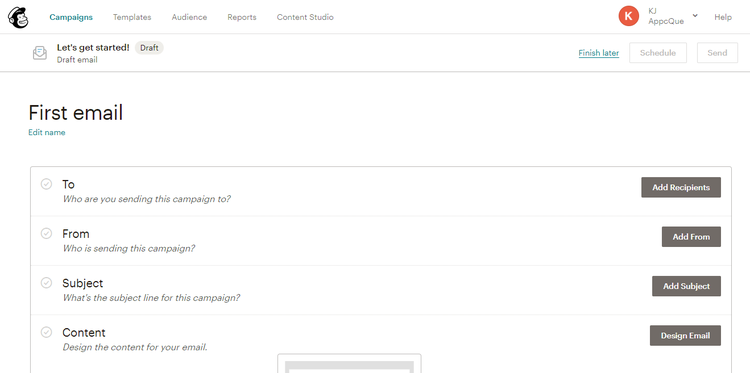You launched your own business. Word of mouth can only get you so far. Now it’s time to accelerate growth by marketing your company.
The goal of marketing is to find the right audience for your products or services and apply the appropriate marketing strategy to reach that audience. Fortunately, small businesses can choose from a plethora of marketing tactics to achieve their objective.
This practical guide outlines seven strategies to successfully execute marketing for your small business.
What to consider when selecting a small business marketing strategy
Before jumping into the strategies, review these considerations affecting how to market your business.
Marketing goals
Building your marketing strategy starts with defining goals. Are you looking to acquire new customers, oversee your company’s reputation, referred to as reputation management, or other objectives like customer retention or increasing the average purchase amount per customer?
Setting goals allows you to construct a marketing plan that aligns the limited time, resources, and budget at your disposal towards the local marketing strategies that achieve your business and marketing objectives.
Customer and market insights
Another consideration is understanding your target customers. What motivates them to seek a business like yours? Where do they spend time online? Insight into these kinds of attributes dictates the best ways to reach your customers.
Along with this, learn your market dynamics. Who are your competitors and how do they market to customers? Which industry trends could change how customers engage with your business?
Research is the means to acquire these insights. Look for industry info online, call competitors, and survey your customers.
ROI
Marketing for small business relies on limited resources and budgets. Hence, successful business marketing focuses efforts around the tactics that generate the best return on investment (ROI) for your marketing dollars.
To identify which deliver compelling ROI, you must test different strategies, collect real world results, then evaluate if it’s worthwhile to invest more into the strategy or pursue others.
7 ways you can market your small business
Many cost-effective marketing channels exist for small businesses. The following highlights impactful digital marketing tips to grow your company. Whether you’re looking to market a new business or perform B2B marketing, these strategies work for any type of organization.
1. Business website
A business website provides the foundational marketing component to reach today’s digitally-driven consumer. A website serves as your company brochure, educating potential customers on what you offer, and why they should buy from you.
In addition, your site serves as the destination consumers arrive at from online strategies such as a Google search or an email marketing campaign.
You can choose from several options to set up a website without costing a fortune or requiring technical knowledge. Even a Facebook page can serve as a proxy for your website, albeit temporarily while you prepare a proper website.
Tips for using a business website:
Here are tips to help with using a website in your sales and marketing efforts.
- Incorporate SEO: Consumers rely heavily on search engines, such as Google, to discover businesses like yours. So be sure your website is designed for search engines. This is called search engine optimization (SEO). It involves both technical aspects of how your site is built as well as the type of content it includes. If you use a content management systems (CMS) to build your website, the technical part of SEO is incorporated. Then it’s just a matter of looking at inbound marketing techniques to address the content piece.
- Support mobile devices: Everyone owns a mobile phone today, and uses it to execute a variety of online tasks, including researching businesses. A poor mobile website drives away potential customers. In fact, the prevalence of mobile phones in our lives means it’s more important that your website works correctly on mobile phones and tablets than on a desktop computer.
- Employ a CMS: Website creation is easier than ever with a CMS like Wix. Such software platforms provide tools to build a website with no technical skills required. Whether your company performs B2B sales or photography services, a CMS can deliver a professional looking website at a fraction of the cost of hiring a professional. It also includes SEO best practices and support for mobile devices.

The Wix interface guides you through the website creation process. Image source: Author
2. Google’s marketing options
We know Google as a search engine, but the company also offers many marketing options. You can reach a large audience at reasonable costs. Because of this, Google is a vital part of small business marketing strategies.
Two areas lie at the heart of Google’s marketing options for small businesses: search engine marketing (SEM) and Google My Business.
With SEM, businesses pay for text ads to appear above Google’s search results, but that payment occurs only when a consumer interested in your offerings clicks the ad to visit your website. Small businesses gravitate to SEM because of this model, and some use SEM as their only marketing strategy.
With Google My Business, companies provide Google with business information which Google then uses across its products, including its popular search engine and Google Maps services. By supplying these details to Google My Business, your company receives exposure to Google’s tremendous base of users. Moreover, you can read and respond to customer reviews, and receive statistics such as how many customers Google sent to your business. Best of all, using Google My Business costs you nothing.
Tips for using Google’s marketing options:
Use these suggestions to get you started with Google’s vast marketing opportunities.
- Adopt Google My Business: With free exposure for your business, there’s no downside to using Google My Business. In addition, you ensure your business information is correct on Google. Erroneous business details, like a wrong phone number or incorrect business hours, can occur if Google must rely on other information sources for your business. So avoid this and reap rewards by providing accurate facts about your business to Google.
- Weigh SEM pros and cons: I worked at the company that created search engine marketing, so can attest to its efficacy in delivering results for small businesses. That said, SEM is complex and time consuming to set up and manage. You’ve got to understand its auction bidding system, the use of keywords and negative keywords, how ad groups work, and much more. So consider the advantages of SEM as a marketing tool against the time investment required to execute it. You can always pay an expert to do it for you, or skip it in favor of other marketing options.
- Investigate other Google services: Google’s numerous advertising capabilities include a click-to-call option that increases phone calls to your business, the ability to run banner ads across millions of websites outside of Google, and opportunities to drive customers directly to your physical store or office by buying ads on Google Maps. The compelling reason to investigate Google’s offerings is that you can set any size budget that works for your business.
3. Social media engagement
Social media has grown into an effective marketing strategy for small businesses. Social networks such as Facebook possess deep customer analytics and data insights to the point where you can easily find consumers fitting your ideal customer profile and target your advertising to this audience.
Moreover, social media is key to reputation management. Anyone can post unfavorable comments and reviews online about your company. You can lose customers because of these negative posts.
So you must be involved in social media. Because of this, its advertising effectiveness, and low cost, if your time and budget limitations require you to choose just one marketing strategy, social media should be your first choice.
Tips for using social media:
Here are some handy tips to integrate social media into your marketing strategy.
- Choose the best social network for your business: Not all social networks deliver the same results for a company. Choose your social networks based on the nature of your business. For instance, Pinterest works great for retailers while LinkedIn may be the better choice for B2B marketing strategies.
- Prioritize Facebook: If you can only choose one social network, go with Facebook. It’s one of the biggest social networks in the world and also owns Instagram, another popular social media network.
- Adopt software for multiple networks: Even large corporations lack the resources to manage a presence on Facebook, Twitter, and the dozens of other social networks where consumers hang out. If you must maintain multiple social media accounts, turn to software solutions that specialize in social media management. With one software platform, you can post content to several social media sites at once, and receive notifications to catch and address negative comments.
- Respond quickly to comments: Set up a system where someone in your organization can respond to negative customer comments within 24 to 48 hours. Consumers know it’s not possible to please everyone, so it’s less the unfavorable comments that are the issue, but a lack of response from the business. Quickly addressing such comments conveys you’re serious about customer service.
4. Email marketing
Small businesses are most often associated with direct marketing. This strategy involves a business reaching out directly to a specific group of customers, such as delivering flyers to nearby residents.
One of the most popular direct response marketing techniques is email marketing. It’s flexible enough to work for any type of company. A retailer can execute an e-commerce email marketing strategy while an insurance agency can send an email newsletter with insightful advice like home security.
Another important benefit is the ability to tailor emails to different customer segments. For example, send a welcome email to new customers to strengthen that relationship. Meanwhile, repeat clients might get a follow-up email thanking them for their business with a coupon to incentivize additional purchases.
This personalized messaging captures the attention of busy consumers far more effectively than a one-size-fits-all blanket email. As a result, personalized emails increase the likelihood of customer engagement and the ultimate purchase of your company’s goods and services.
So how do you collect consumer email addresses to implement email marketing? This can be done through the purchase of an email list, or by taking the time to collect the emails yourself by asking customers to sign up as you build up your client base.
Tips for using email marketing:
Small business email marketing can seem intimidating, so here are suggestions to help you.
- Use email marketing software: Managing email communication is challenging without the help of email marketing software. Solutions such as Mailchimp streamline email marketing execution with automated workflows.
- Employ customer segmentation: Segmenting your customer base is the basis for creating personalized email communication. Customer segmentation is attainable through the use of CRM software, with some vendors offering free versions, while the best email marketing software will also deliver customer segmentation capabilities.

Software such as Mailchimp walks users through the email marketing process. Image source: Author
5. Inbound marketing
Inbound marketing deepens customer relationships over time by building trust and delivering value through a variety of digital tactics. These tactics attract customers to your business rather than you pushing outbound messages, like ads, to them, hence the name.
An example is posting articles on your website about topics related to your business. Customers seeking information about these topics are incentivized to visit your website, and since they arrived of their own volition, they tend to think favorably of your business.
In addition, inbound marketing strengthens your website’s SEO. Also, posting insightful content positions you as an expert in your industry. And because you’re delivering value to consumers even before they become customers, inbound marketing improves your business reputation as well.
Tips for using inbound marketing:
Follow these suggestions to put inbound marketing to use.
- Provide quality content: Inbound marketing only works if the content delivers value to customers. Perhaps article writing is not your expertise. Opt for another content approach like videos or a webinar instead. By implementing the kind of content you feel comfortable with, it will innately deliver the level of quality valued by customers.
- Use software to nurture leads: As customers come to you for the great content, you need a means of nurturing and tracking these leads to the next stage of the sales funnel. Adopt a CRM to help with this. Software such as HubSpot CRM provides automation tools that automatically trigger actions that nurture your leads.

HubSpot guides you through setting up an automated workflow to simplify lead nurturing. Image source: Author
6. Mobile marketing
Mobile marketing is a powerful strategy for small businesses. It lets you drill down to a specific customer, delivering your message in the most intimate setting available today, a customer’s mobile device.
Mobile marketing offers many benefits. Nearly all consumers own mobile phones, so you can reach a large audience. Mobile use is also related to a sense of urgency. Consumers look for a business like yours on their mobile device because they possess an immediate need, for example, to find a highly-rated restaurant for lunch.
Through mobile marketing, you raise customer awareness about your business right when they need you most.
Tips for using mobile marketing:
Follow these tips to reap the rewards of this underused marketing strategy.
- Use mobile apps: Popular mobile apps catering to small businesses, such as Yelp and Foursquare, get your business in front of customers in your vicinity. For example, consumers turn to Yelp to research many types of businesses from restaurants to lawyers. Ensure your business appears on these apps (most allow you to provide business info for free). Also consider advertising for placement of your business listing in a highly visible location within the app.
- Apply retargeting: Retargeting is the ability to show your ads specifically to consumers who visited your website, but did not complete a sale. Through retargeting, you subtly remind them of your offerings, and thus, re-engage them in your business. Several companies provide this capability, such as Google, of course, and Criteo. One advantage of retargeting is that it works across devices, so wherever a consumer may be, your reminder ad can be shown.
7. Video marketing
Video content consumption is at an all-time high, and consumers watch videos to make purchase decisions. This makes sense when you consider a research study that confirmed 65% of us are visual learners. A video displays detailed info of a product or service along with visuals to help viewers understand the value delivered by the offering.
Video marketing provides a range of options to promote your business. If you offer a complex product, an educational or how-to video works best. A B2B service like an accounting firm or software company might seem stuffy, so humanize your organization with an emotional video explaining the personal story of your company’s history.
Tips for using video marketing:
Creating an online video no longer requires expensive equipment. Your mobile phone can do the trick. Here are additional tips to make video marketing work for you.
- Be yourself: While you want to have a loose script so that the video is focused, the key is to be yourself. Consumers look to connect with businesses in a human way, so being overly salesy can run counter to that.
- Leverage YouTube and Facebook: As one of the largest platforms for watching video content in the world, YouTube is a great place to run an online video commercial. That said, don’t overlook Facebook. The social media site offers video advertising opportunities, so couple a video ad on Facebook with your other social media efforts.
- Make it entertaining: The video ad works best when it’s entertaining and short. Keep your video to a minute or less, depending on the subject matter. A how-to video can be longer while a video ad should be 15 seconds or less. Even with this tight timing, it’s possible to create a fun, humorous, or exciting video that captures the attention of your audience.
Final advice for marketing a small business
Marketing is a process of experimentation. Pick a strategy and test it. Measure the results using marketing metrics like ROI to see if that strategy achieves your goals.
If not, don’t become discouraged. Simply experiment with a different strategy, and keep trying different ways to market your business until you strike gold.




